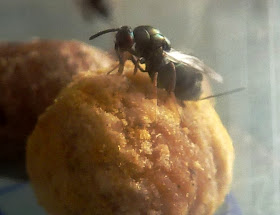Bees are good. We like bees. They pollinate and are pleasant to watch. They are of course also wild creatures subject to the stresses that any other organism has to deal with, and one of these is parasitism. With
our garden bee logs, new and old, almost completely occupied by the red mason bee
Osmia rufa, it is not surprising that other nesting sites are sought out. Sometimes the chosen spot is not a good one, as in this case where a nest had been attached between a hoe and the inside of our tool shed -
we'd noticed the nest, but the hoe fell down anyway, taking some of the cells and cocoons with it.
 |
| Osmia rufa nest - the open sides of the cells were pressed against the handle of a hoe until it fell down. Note the larva in the bottom centre cell (now taken away to be raised indoors) |
 |
| The inside of an O. rufa cell - note the plug made of numerous small pieces of mud tamped into place by the prongs on the female's head. |
 |
| A cocoon and pollen ball (larval food supply which includes a small amount of nectar) from an O. rufa cell. |
Being a fan of bees (well, wildlife in general really) and ever-curious, I collected the cocoons that had been displaced (about a third of the whole nest) and brought them indoors to be put into a hatchery. I was of course hoping to see the bees emerge and release them, but a few days later something else happened entirely; the hatchery was full of small parasitic wasps - Monodontomerus obscurus (Hymenoptera, family Torymidae) - 21 in total.
 |
| Some of the Monodontomerus obscurus hatched from O. rufa cocoons |
 |
| A female (note the ovipositor) M. obscurus apparently feeding on an O. rufa larval pollen store. |
Although the larger parasites of
O. rufa are listed in Baldock (2008), there seems to be relatively little mention of this aspect of the bee's natural history even though it is a familiar and popular species. However,
Krunic et al. (2005) provide more detail and note that
M. obscurus can suppress
O. rufa populations in some nesting situations such as paper tubes and hollow reeds.
This is a normal part of bee ecology of course - and the wasps are interesting little jewels in their own right, so (as ever) I took the opportunity to have a look at one of them (a female) more closely. Males are present but smaller (approx. 4mm long without appendages, females approx. 5mm) and lack the ovipositor that female use to lay eggs into the bee cocoons.
 |
Female M. obscurus - approx 5mm long plus 2-3mm of ovipositor
|
 |
| Close-up of the head of a female M. obscurus - note the red eye with short white bristles, plus the sculpturing on the head and thorax. |
 |
| Close-up of the hind femur of a female M. obscurus - note the sculpturing on the leg and the 'finger-print' pattern of sculpturing on the abdomen behind it. Also, the edges of the thoracic plates bear fringes of short white bristles, presumably to protect the membranous joints. |
 |
| O. rufa cocoon with M. obscurus exit hole. |
With the cocoon having disgorged its parasites, there was only one thing left to do - open it up to what was left inside.
 |
| The content of an O. rufa cocoon after emergence of M. obscurus. |
I did wonder of there would be much evidence of the juvenile bee, but very little was left, having presumably been consumed by the wasp larvae - there are a few fragments (e.g. bottom right) but nothing more. Most of the invertebrate material consists of pupal skins of M. obscurus - unsurprising given the number that emerged. There is some frass (faeces) and bits of dried mud from the nest which must have fallen in before the cocoon was spun. Top left is a dead female wasp who didn't emerge fully from pupation. She is of course also in a hatchery just in case she releases smaller parasites of her own...
References
Baldock, D.W. (2008).
Bees of Surrey. SWT, Woking.
Krunic, M., Stanisavljevic, L., Pinzauti, M. & Felicioli, A. (2005). The accompanying fauna of
Osmia cornuta and
Osmia rufa and effective measures of protection.
Bulletin of Insectology 58(2): 141-152.










No comments:
Post a Comment